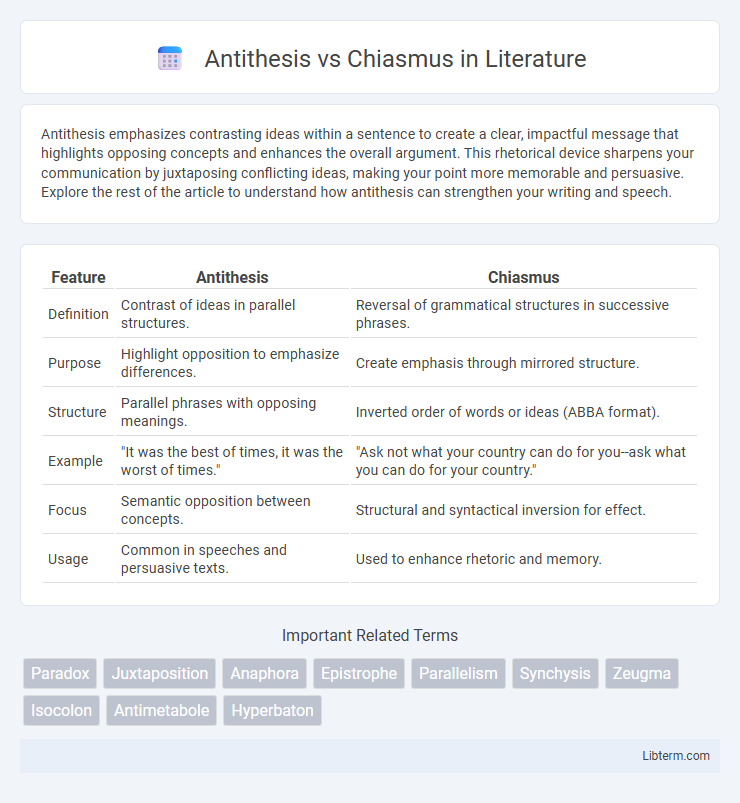Antithesis emphasizes contrasting ideas within a sentence to create a clear, impactful message that highlights opposing concepts and enhances the overall argument. This rhetorical device sharpens your communication by juxtaposing conflicting ideas, making your point more memorable and persuasive. Explore the rest of the article to understand how antithesis can strengthen your writing and speech.
Table of Comparison
| Feature | Antithesis | Chiasmus |
|---|---|---|
| Definition | Contrast of ideas in parallel structures. | Reversal of grammatical structures in successive phrases. |
| Purpose | Highlight opposition to emphasize differences. | Create emphasis through mirrored structure. |
| Structure | Parallel phrases with opposing meanings. | Inverted order of words or ideas (ABBA format). |
| Example | "It was the best of times, it was the worst of times." | "Ask not what your country can do for you--ask what you can do for your country." |
| Focus | Semantic opposition between concepts. | Structural and syntactical inversion for effect. |
| Usage | Common in speeches and persuasive texts. | Used to enhance rhetoric and memory. |
Defining Antithesis and Chiasmus
Antithesis is a rhetorical device that juxtaposes contrasting ideas in parallel structures to highlight differences, such as "It was the best of times, it was the worst of times." Chiasmus involves the inversion of grammatical structures or ideas in a crisscross pattern, typically ABBA format, exemplified by "Never let a fool kiss you or a kiss fool you." Both devices enhance emphasis and clarity but differ in structural arrangement and the way contrast or reversal is presented.
Historical Origins of Both Rhetorical Devices
Antithesis originates from ancient Greek rhetoric, prominently used by Aristotle to create a clear contrast between opposing ideas in classical oratory and literature. Chiasmus, also rooted in Greek tradition, appears in early classical texts and is characterized by the reversal of grammatical structures to emphasize symmetry and balance. Both devices were widely employed by Roman orators such as Cicero to enhance persuasive speech through structured contrast and mirrored phrasing.
Key Structural Differences
Antithesis contrasts opposing ideas within parallel grammatical structures to highlight differences, typically using phrases like "Speech is silver, but silence is golden." Chiasmus reverses the order of words or ideas in successive clauses, forming an X-shaped pattern, as seen in "Never let a Fool Kiss You or a Kiss Fool You." Antithesis emphasizes contradiction, while chiasmus focuses on inverted symmetry in sentence structure.
Common Purposes in Rhetoric
Antithesis and chiasmus both enhance rhetorical impact by creating contrast and emphasizing key ideas through structured phrasing. Antithesis highlights opposing concepts within parallel grammatical structures to clarify differences and provoke thought. Chiasmus reverses the order of words or ideas in parallel clauses, intensifying the message and aiding memorability in speeches and writing.
Famous Examples in Literature
Antithesis employs contrasting ideas in parallel structures, as famously illustrated by Charles Dickens in "A Tale of Two Cities": "It was the best of times, it was the worst of times." Chiasmus, exemplified by John F. Kennedy's inaugural address, reverses the structure of phrases, as in "Ask not what your country can do for you--ask what you can do for your country." Both rhetorical devices enhance literary and rhetorical impact by emphasizing opposition and symmetry through strategic word order.
Effects on Audience Perception
Antithesis creates a stark contrast between opposing ideas, emphasizing differences that enhance clarity and provoke critical thinking in the audience. Chiasmus reverses the structure of phrases, producing a mirror-like effect that reinforces concepts and makes statements more memorable. Both rhetorical devices engage listeners by highlighting relationships between ideas, but antithesis sharpens distinction while chiasmus deepens resonance.
When to Use Antithesis vs Chiasmus
Use antithesis to emphasize contrast between opposing ideas in a balanced sentence structure, highlighting clear distinctions for persuasive or rhetorical effect. Choose chiasmus when you want to create a mirror-like reversal of words or phrases to enhance memorability and artistic expression. Both devices serve different stylistic purposes, so antithesis fits best for direct opposition while chiasmus suits symmetrical, thought-provoking statements.
Misconceptions and Overlaps
Antithesis and chiasmus are often confused due to their structural opposition and mirroring of ideas, but antithesis emphasizes contrasting concepts in parallel structures while chiasmus features a reversed grammatical order creating a symmetrical pattern. Misconceptions arise when chiasmus is mistaken for antithesis merely because it contains opposition, ignoring that chiasmus's hallmark lies in its crisscross arrangement rather than just contrast. Both devices overlap in employing balance and opposition to enhance rhetorical effect, yet careful analysis reveals their distinct syntactic and semantic functions.
Practical Tips for Writers
Writers aiming to employ antithesis and chiasmus effectively should focus on clarity and balance, ensuring contrasting ideas in antithesis are succinct and parallel for maximum impact. Chiasmus requires a mirrored structure that emphasizes the reversal of concepts or words, enhancing rhetorical power and memorability. Practicing these techniques through sentence variation and revision helps integrate them naturally into persuasive or poetic writing.
Summary Table: Antithesis vs Chiasmus
Antithesis involves contrasting ideas placed in parallel structures, emphasizing opposition within a sentence, such as "It was the best of times, it was the worst of times." Chiasmus reverses the order of words or phrases in parallel clauses creating a mirror-like structure, exemplified by "Never let a Fool kiss you or a kiss Fool you." The key distinction lies in antithesis highlighting contrast between opposing concepts, while chiasmus focuses on a syntactic inversion to reinforce meaning or create emphasis.
Antithesis Infographic

 libterm.com
libterm.com